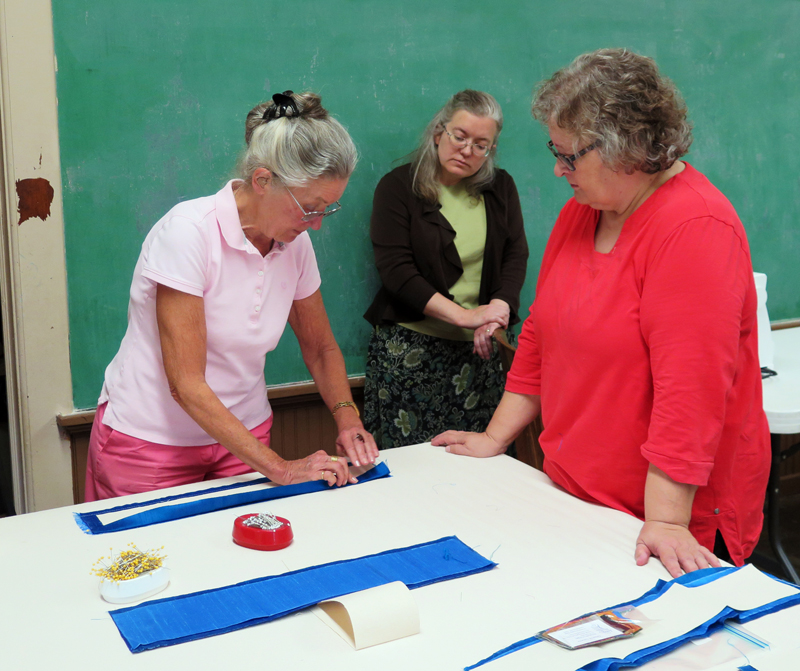By Anne Marie Amacher
The Catholic Messenger
DAVENPORT — When Kathryn Amato’s husband brought home linens from St. Mary Parish to be cleaned, she observed that many had stains that could not be removed and many also were frayed. “I looked into replacing some, but it is expensive.”

Elizabeth Morgan, left, shows women how to make stoles during a workshop on church linens Sept. 22 at St. Mary Parish in Davenport. Watching Morgan are Kathryn Amato of St. Mary’s in Davenport and Mary Appel of St. Patrick’s in Ottumwa.
So Amato thought, why not make them? The linens include altar cloths (also called fair linens), purificators, corporals, palls, stoles and more. In her search to learn how to properly make linens she visited Elizabeth Morgan’s website churchlinens.com. Amato invited Morgan to give several linen seminars at St. Mary’s from Sept. 19-22. Parishioners from St. Mary’s in Davenport and St. Patrick Parish in Ottumwa attended the seminars as did several women from the Chicago area.
Morgan, explaining the virtue of hand-making church linens, said the Gospel calls followers to feed the hungry and clothe the naked. Money spent on other things reduces the amount spent on the poor. Plus, making linens allows parishioners to give time and talent to the church. “It’s all about stewardship.”
She said she began making linens at the direction of her bishop, Bishop David Ball of the Episcopal Diocese of Albany, N.Y. (Anglican Church). He asked her to start a ministry to teach women how to sew linens and vestments. She began in 1985 in her parish and spread out to all seven deaneries. “The reception was astounding.”
She admits that she is not a seamstress. “I was an aspiring zoo veterinarian.” The handmade linen ministry came to her with the guidance of the Holy Spirit, she said. In Davenport, she taught her participants basic competence and how to make things “extraordinarily beautiful with their own talents.” This includes embroidery, gold or silk work, crochet, painting on silk and other embellishments. “Women, and men, need to find their talents and skills and go with it.”
Not everyone will master linen-making, but working as a group draws out talents, she believes. Learning the basics and the foundation are important. “You engage the beauty and support the body of Christ.”
St. Mary’s participants learned basic skills on stitching. “They came away knowing how to make altar linens,” Morgan said.
She noted that the women from the Chicago area who attended were highly skilled, “but they missed the competence.” The women agreed. “We missed the background and fundamentals. We are picking that up now,” they said.
The women were part of the Canons Regular of St. John Cantius, a Catholic cluster of parishes in the Chicago area. They attend the parishes of St. John Cantius in Chicago and St. Peter in Volo. Mary Sue Lareau of the Volo parish has been involved in her parish’s sewing guild for years. “As soon as we heard of this seminar, we wanted to learn and come. There is so much information and talent that we have learned from Elizabeth.”
Michele Yarbrough, also of the Volo parish, said she had struggled for years with what she understood to be the correct way of making linens. “Elizabeth has made it a lot easier. We can still be creative, but do things much more efficiently than we have been doing.”
Morgan taught the women how to make a stole, giving them simple tips to save time and effort that she learned within the past few years. “Take your skills and talents and run with it.”
Mary Appel of St. Patrick’s in Ottumwa learned about the seminars in The Catholic Messenger. She said sewing has been one of her interests for years. In the past, she has made a stole and cassock. Listening to Morgan was instructive, she said, noting that the seminar was “top rate and top of the line.”
Amato said the six women who attended the seminar from St. Mary’s “are now very enthusiastic about starting a regular sewing group. It would focus on liturgical sewing, primarily making altar linens. “As a matter of fact, some of us at St. Mary’s have already provided the parish with a few small linens that we made by following the instructions in Elizabeth’s book.”
St. Mary’s sewing group is a part of St. Martha’s Guild, a general service and hospitality organization with membership open to the parish’s women.












Hi, I’m very interested to learn how to make alter clothes. I’m in Ireland though. It’s not possible to buy them here so it would be wonderful to make them. Do you have any contacts on this side of the Atlantic? Your help would be much appreciated.
Thank you